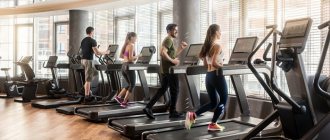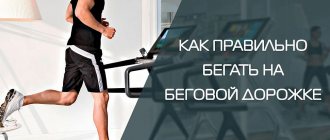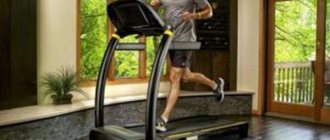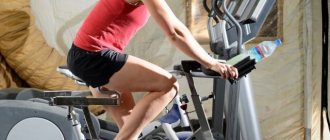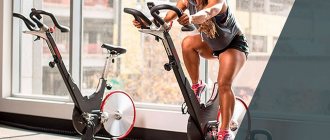Exercise bike cardio equipment
gives a more serious load on the body than a stepper. Good for warming up and even for losing weight.
You just need to work quite actively on it. Leisurely pedaling, accompanied by a conversation with a neighbor, will not give results,
There are certain rules for training on an exercise bike. The seat height needs to be adjusted. If the seat is installed correctly, your leg should be fully straightened when you bring the pedal to its lowest point. If you pedal with bent legs, you can injure your knee joint.
In general, whether you are doing aerobic training or strength training, you should have your workouts clearly planned. What exercises to do today, which on the next training day, how many kilometers to travel (run, walk), at what speed, in what period of time.
Exercise bike
Each exercise should be planned down to the smallest detail. Then you will not be able to relax during training.
Let's see how to train using an exercise bike as an example. Let's say that a person wants to lose weight.
He definitely keeps a training diary. In the diary, he notes the distance he covered in the last training session, the speed and load.
Exercise bikes have a lever that controls the load. The higher the load, the more difficult it is to pedal.
Now you will understand why it is so important to keep a training diary. For example, a student rode an exercise bike 5.3 km at a speed of 12 km/h, with a load of 4, in 40 minutes. Meanwhile, her task is to drive 7 km at the same speed and load.
Will she be able to chat with her friend when she needs to set a small personal best? There's no time for talking anymore. And after she completed the workout. She writes in her notebook: 5.6 km at a speed of 12 km/h, with a load of 4, in 42 minutes
For example, a student rode an exercise bike 5.3 km at a speed of 12 km/h, with a load of 4, in 40 minutes. Meanwhile, her task is to drive 7 km at the same speed and load. Will she be able to chat with her friend when she needs to set a small personal best? There's no time for talking anymore. And after she completed the workout. She will write in her notebook: 5.6 km at a speed of 12 km/h, with a load of 4, in 42 minutes.
Our athlete will receive a good load for her. After this, there is no need to go to do strength exercises. The body is already tired.
That's why I recommend dividing strength and aerobic exercise into days. I'm not talking about doing a 10-minute aerobic warm-up before your workout.
The most traumatic places when exercising on an exercise bike are the knees. Therefore, do not press the pedals sharply, start gradually so as not to sprain your knee ligaments. A properly adjusted seat height will also help you prevent knee injuries.
People often ask how to place your foot on the pedal? There are two options: place the pedal on the middle of the foot or on the toe. Traditionally, we ride bicycles with the pedal placed in the middle of our feet. The only difference is this: if you put the pedal on the toe, the calf muscles are involved in the work. If the pedal is placed in the middle of the foot, the muscles of the thigh and buttocks work.
Sometimes “stirrups” are placed on the pedals; You can ride on such a trainer with your feet on your toes. Without “stirrups” the leg will not hold up and will keep slipping. Therefore, it is best not to bother and place your foot on the pedal with the center of your foot.
You don't need to ride on aerobic machines, but work. If you have an aerobic workout today, and you work out on an exercise bike and don’t even break a sweat, then you wasted your time.
Pedaling an exercise bike for a long time is somewhat tiring for the psyche. The landscape does not change, you look at one point. But there is an interesting solution to this issue.
One of my friends goes to a fitness club, where they came up with an interesting thing for exercise bikes. They have a separate room with only exercise bikes. And there is the same simulator for the instructor.
Participants arrive at a certain time and a group lesson takes place. And the instructor sits opposite and pedals along with everyone else, changing the speed and strength of the load. All students repeat after him.
This makes training much more interesting. When a person studies in a group and everyone does the same as you. Such activities become much more interesting and fruitful.
My friend’s figure is very good, not an ounce of excess fat.
Maybe your fitness club can organize the same classes.
Tips for Effective Cardio Workouts
Cardio exercises should be regular. This is the only way to improve the entire blood supply system of the body. With periodic training, the body will perceive the load as a lot of physical stress and will get tired.
In order to achieve good results, you will have to do cardio often. How else would you like it? If you want a beautiful body, you have to sweat! 5-6 times a week for 40-50 minutes.
As your training level increases, the intensity of your training should increase. Those. If 3-4 alternations of intervals no longer exhaust you as much as before, increase the number of these alternations and the duration of each interval.
It is important to start and end cardio training with a gradual increase/decrease in heart rate - the heart does not like sudden changes in intensity. If you experience tingling in your side, continue training.
Just reduce the intensity a little until these sensations pass.
Don't forget to drink during cardio exercise. Not only water comes out with sweat, but also useful salts and minerals. Therefore, it is better to use mineral water without gas or isotonic water.
When to do cardio?
There are two views on this issue. First, you can train at any time. The second is to train better when glycogen levels are low. This corresponds to the morning awakening and the end of strength training.
Immediately after sleep, insulin and glycogen levels are low. This means that fat will become the main source of energy for the body. Those. You do not need to burn glycogen for 20-30 minutes first. You save time.
Plus, a morning cardio workout is a sure way to recharge your energy for the whole day, due to the release of endorphins into the blood. The only condition is that you must enjoy training.
How to achieve this? Do cardio with your favorite music! It should charge and encourage you, give you strength and motivation. Believe me, it works!
After strength training, the muscles are warmed up and glycogen stores are also depleted. Medium-intensity 20-minute cardio exercise is a wonderful means of burning fat and accelerating recovery by dispersing blood throughout the body.
It is important to remember that cardio is an oxygen-consuming process. Always ensure easy access of air to the body
This means that if you study at home, ventilate the room well.
If you do cardio outside, dress appropriately for the weather. There is no need to wear “a hundred clothes” on yourself in warm weather. You will simply sweat a lot, losing valuable minerals and salts, and the fat will remain with you.
If your goal is to lose weight or get lean, then refrain from eating for at least one hour after cardio.
Treadmill training at different levels
There are several categories of trainees: beginners, beginners and advanced levels. Everyone should have their own workout intensity.
- For beginners, there is an easier option: walk for four minutes, then run for one minute. And so you alternate in about five approaches. Your running speed should be about 75% of the maximum you are capable of. In total, the workout will take about 25 minutes.
- Beginner level: walk for four minutes and run for two minutes. Speed is calculated using the same principle. Five approaches and only half an hour.
- The advanced level has equal proportions - 2 minutes of running and two minutes of walking for five approaches. It's about 20 minutes.
Separately, you can diversify the intensity of your running by increasing and decreasing the speed, changing the level of incline during the run (provided that this can be done without leaving the surface).
Benefits of working out on a treadmill
Until now, scientists argue about the benefits and harms of running, citing various arguments. But people continue to run and achieve good results in losing weight, strengthening their muscles, improving their health and endurance of the whole body.
Recently, adherents of a healthy lifestyle have given their preference to treadmills, working out on them at home or in the gym, because:
- they have a smooth surface, devoid of depressions and bumps, which eliminates the occurrence of traumatic situations;
- you can vary the incline yourself, which will simulate climbing uphill, which will increase the load on the muscles;
- there is no sudden stop at the end of the workout, because the belt stops gradually, which has a beneficial effect on the heart;
- they contain various useful indicators, such as measuring heart rate, speed, distance, time, calories, which allow you to monitor the progress of your workout.
- Some models are quite compact, as they fold up perfectly and therefore do not take up much space in the house.
With active exercise on a treadmill at least 3 times a week, you can get the following pleasant results:
- stabilize the functioning of the heart and blood vessels;
- strengthen your immunity;
- work out the muscles of the legs and abs;
- train the gluteal and back muscles;
- improve metabolism;
- It's good to lose weight;
- improve lung function;
- improve your mood and get rid of stress.
Training programs
The effectiveness of training depends on two factors - nutrition and a properly selected program.
There are a large number of different programs:
- Uphill program. Designed for intense training that simulates mountain climbing/jogging. The slope for such training is at least 10%. However, it requires good preparation, as it uses almost all muscles.
- The “intensive running” program is intended for strength and cardio training. Its beginning is similar to a jog, which should be replaced by a speed run, switching to an intense run.
- Classic built-in programs.
- Fast start.
- Interval training, which allows you to vary the intensity.
- Program for active fat burning.
- Program for working out the gluteal muscles.
- Calorie burning program.
- Program type: Route or track.
Correct use of treadmills
Treadmills are a great addition to your home gym, providing an effective and relatively safe cardio workout. Home segment exercise machines have a low price compared to commercial class models, but also
Owning a home treadmill allows you to avoid spending money on a gym membership. In addition, you can exercise on a home exercise machine whenever and as much as you want. However, for
A treadmill is an expensive piece of equipment that requires regular maintenance if you want to reduce the likelihood of costly repairs. Therefore, every treadmill owner should read the instructions that come with it.
A treadmill, like any other piece of equipment, can be dangerous if used improperly or without proper safety precautions. You may have the best treadmill in the world, but... The treadmill is delivered in a minimally disassembled condition
Assembling the simulator yourself is not difficult. The packaged model is secured with safety straps that lock the folding mechanism, which prevent the treadmill from opening during the process.
The treadmill is delivered in a minimally disassembled condition. Assembling the simulator yourself is not difficult. The packaged model is secured with safety straps that lock the folding mechanism, which prevent the treadmill from opening during the process.
Gyms use professional-grade electric treadmills designed for commercial use. These treadmills can withstand intensive daily use by users with different settings. Commercial models are equipped with a powerful engine, comfortable
If you want to take your home workouts even more seriously and keep your machine in top working order, then you can't do without popular treadmill accessories. Mat for
The warranty period for exercise equipment depends on the manufacturer and can range from 6 months to 3 years. What items are covered by the warranty? Warranty periods for various manufacturers Why?
Over time, using the exercise machine, the tension of the running belt may weaken or shift relative to the center. This is quite normal, as the running belt tends to stretch with use. Tension
Of the numerous sports accessories, there are both necessary and those that are only of an aesthetic nature. A treadmill mat (cardio exercise mat) combines these two functions. Why do you need a rug?
How to turn the trainer on and off?
This article will only cover electric treadmills, as you only need to start walking to enable mechanical options. The use of sensors and devices on mechanical tracks is similar to electrical ones.
Well, if you don’t want to waste time reading the material at all and want to figure it out yourself, read only the minimum basic information :
- stand on the side runners and grab the handles;
- press Quick Start (usually a large colored button);
- you start running;
- adjust the speed to the desired level using two large switches;
- stop the movement with the Quick Start button or the big red button.
If you want to use your treadmill as little as possible, you don't need to know anything else. Well, if you plan on regular training, read on.
By the way, on many tracks you should simply press the Start button twice. After this, by default, 2-3 seconds after pressing, movement begins at a minimum speed.
What you need to know and consider during training
The treadmill benefits the entire body, because with its help at home or in the gym you can move all parts of the body. Intense running and walking not only help you lose weight, but also helps:
- increase endurance;
- eliminate cellulite;
- speed up metabolic processes;
- improve the functioning of the respiratory and cardiovascular systems.
A significant advantage of a treadmill is that you can run or walk quickly on it in any weather and time of day. You can independently adjust your study schedule, focusing on the availability of free time and desire. Exercises on this simulator are cardio exercises. By doing exercises, you can burn up to 650 kcal in an hour of training. In order for classes to bring the expected effect, you need to know how to do it correctly.
Running on a track is easier than running outside. To make training more like street jogging, you should try not to hold on to the handrails, and also change the level of inclination of the surface. It is necessary to gradually increase the duration of classes, warm up before, and drink fluids during training.
A pressing question among beginners is how long to run to lose weight. You need to train for 40-60 minutes, this is the only way to achieve maximum fat burning. It’s better to start with short 15-minute runs, but every day increase the time by 5-10 minutes.
Don't set yourself impossible goals, such as losing 10 kg in a month. You need to be prepared for the weight to come off smoothly and gradually. Haste will only harm the body. You can't train every day. Give your muscle tissue a rest. The correct exercise program is training three times a week, every other day.
Expected results
Depends on the running speed and the person’s own weight. Jogging at a moderate pace burns 100 calories every mile. A half-hour workout at a speed of 5.5 km per hour allows you to get rid of 121 calories. The higher the speed, the faster the calories are burned. Weight has a similar effect. The more a runner weighs, the more the pounds come off.
Pace is important. It should be such that the person is a little out of breath, but is able to talk to anyone around him. Once the correct pace is established, it must be maintained. This applies to training for both weight loss and the cardiovascular system.
The effectiveness of the treadmill in the fight against excess weight is beyond doubt. The only obstacle to achieving results can be your own laziness. Hardy and persistent people who have a clear intention to lose weight achieve good results with the help of this simulator.
How to turn on the treadmill (detailed instructions)
The electric cardio machine requires careful handling.
When approaching it for the first time, carefully study the instructions for correctly connecting the device.
If there are no instructions (for example, you are in the gym and the track is not yours), at least read our recommendations.
How to turn on the treadmill
First of all, make sure that everything is in order with the mechanism:
- there are no protruding or stripped wires;
- foreign objects that could interfere with the movement of the canvas have been removed;
- the tape is not skewed or too loose (otherwise it needs to be centered and tightened).
What should be done?
And here is the standard launch scheme itself:
Plug the plug into the outlet. The backlight on the display will light up. Is the screen not lit? This means that this model also has a toggle switch (small current switch). Click on it. An important point: stand not on the canvas, but on the side panels. Stay like this until the setup is complete. A self-propelled belt can crawl very quickly; you risk falling. Use the key. Attach one end to the on-board computer, and the other to your tracksuit
If you fall, the key will immediately work and the belt will stop. Now click “Start” and pay attention to the scoreboard. The device will most likely ask you to enter your body weight
Do this by increasing the number using “+” (triangle pointing up) or decreasing it using “-” (triangle pointing down). “Plus” and “minus” will also help you choose the desired speed - in English “Speed”. That's it, let's get started! During training, if desired, use the “Incline” setting – an option to adjust the angle of the belt. It allows you to increase the load by simulating uphill running.
Listen to the track from time to time. A little noise is normal, the main thing is that it is uniform, without squeaks or knocks.
When you stop the machine, reduce the speed gradually.
We wish you a good workout – effectively and with pleasure!
How to use a treadmill for weight loss
Absolutely any workout should begin with a warm-up and warming up the muscles. In the case of a treadmill, this is also necessary to avoid injury and overexertion. As a warm-up, you can walk for 4 minutes at a speed of 4 km/h, jump rope, and so on. In short, engage your lower muscles as you warm up.
Vary your speed during your workout. This way you won’t get mentally tired from monotonous running. Change speed approximately every 8 minutes. You can also increase your running intensity by increasing the incline level of the running belt.
Do interval training or use special weight loss programs programmed into the treadmill. Most modern models with an average price have them, and in a variety of options...
The workout should end with a cool-down or cool-down. To do this, you need to gradually reduce the speed, let the pulse calm down a little, and the muscles return to normal. You can do a little stretching at the very end, which will allow you to noticeably relax and then avoid pain after an intense workout.
Exercise regularly. To lose weight, you need to run at least every other day, or better yet, every day with one day off a week. By the way, running is very effective for losing weight in your legs and thighs, and with intense exercise it will also help you lose weight in your belly. At the same time, to lose weight, you need to run for at least 30 minutes so that progress comes faster.
Some useful tips
In conclusion, we offer you some general tips that will help make your classes more productive:
- safety key – attached to your clothes and to the treadmill: if you suddenly fall, the key will turn off the treadmill; In addition, this tool is simply convenient to stop movement at your discretion, without touching the panel; running without a key is not recommended;
- lace up your shoes - running sneakers need to be laced tightly and firmly so that the shoes fit snugly and the laces do not come undone during training;
- water – an excellent option on the treadmill is a cup holder where you can put a bottle of water, you don’t need to drink a lot, but a couple of sips during your workout will benefit you;
- do not interrupt or cut short your workouts - try to train in such a way that you do not need to interrupt your run, and always do a cool-down at the end;
- use the built-in fan , which is designed to avoid overheating - you can turn it on using the FAN button;
- individual programs - preset programs are of course interesting, but you don’t need to use only these algorithms - create your own programs, make your workouts more varied and different, then your performance will increase.
For greater clarity, watch the video on the topic.
We hope these tips can be useful to you, and now you can not only understand any treadmill, but also train for the benefit of your own beauty, body and health.
People who regularly visit gyms and fitness centers have long been accustomed to the treadmill. But if a person buys this exercise machine for home, then turning on and controlling the treadmill can cause difficulties. In this article we will talk about how to operate the simulator and use it as efficiently as possible.
How to overcome boredom while working out on the treadmill
Bojan89/iStock
Because of this problem, many runners often give up training. Running on a treadmill can become boring and monotonous over time. But to prevent this, do the following:
Try interval training
We've already talked about the benefits of alternating between high and low intensity. Verywellfit recommend the following regimen: a five-minute warm-up, three sets of four-minute intervals (two minutes of fast running and two minutes of easy running), followed by a five-minute cool-down-recovery.
Run with a friend
If you and a friend or coworker go to the same gym, try running on treadmills next to each other. You can motivate each other and provide distractions to speed up your workout time. One of the great things about running on a treadmill is that you don't have to run at the same pace. You'll be able to run with friends you wouldn't normally run with outside due to differences in running pace.
Listen to music
Research has shown that music can play a role in your physical activity. Many people listen to music to push themselves to do more effective workouts.
Using headphones while running outdoors is not safe. Listening to music on the treadmill can be a great way to combat boredom. Choose motivational songs and create a playlist for your workout. This will help you avoid being distracted by watching the clock: you will know when the workout is over by playing the last song in the playlist.
Mix your workout with bodyweight exercises
After a 5-minute warm-up, run at a comfortable pace for five minutes, then step off the treadmill and do strength exercises (2 minutes). The following will be useful: crunches, push-ups, side crunches, lunges and dips. Try doing four sets of running/strength training.
Listen to audiobooks
Whether it's an instructive non-fiction book or an exciting novel, listening to it helps distract you and motivate you to move on. Audible.com is a great resource for finding audiobooks. You will look forward to every workout because... it will allow you to develop both mentally and physically.
Work on improving your running
Treadmills are a great opportunity to work on improving your running speed. Professional runners run at around 180 steps per minute - see how quickly you can get there. Working on your step count can improve your running efficiency, even for outdoor running.
Immerse yourself in a calm, relaxed state
Unlike running outdoors, running on a treadmill does not require close attention to your surroundings and keeping an eye out for cars, cyclists, dogs and other hazards. You don't even need to think about your route. You can just relax and enjoy your run.
Arrange a training session using the “Pyramid” method
After a 5-minute warm-up, run at a vigorous pace (5K pace) for one minute, recover for one minute. Then run at an intense pace for two minutes, recover for two minutes. Run at an intense pace for three minutes, recover for two minutes; run at an intense pace for four minutes, recover for two minutes; Run at an intense pace for five minutes, recover for two minutes.
Then return to the “pyramid” and run at an intense pace for four minutes, recover for two minutes; run at an intense pace for three minutes, recover for two minutes; run at an intense pace for two minutes, recover for two minutes; Run at an intense pace for one minute, recover for one minute. Finish your workout with a 5-minute cool-down.
Alternate running with another cardio machine
Try alternating running on a treadmill with a bicycle or elliptical trainer. If you want to get in a 40-minute cardio workout, run on the treadmill for 10 minutes, then switch to another machine (10 minutes) and continue alternating until you reach your total goal of 40 minutes.
If you run on a treadmill at home and it's your only exercise machine, try running up and down the stairs within five minutes of running on the treadmill.
How to run properly[edit | edit code]
Treadmill training programs
Running technique. While doing exercises on the treadmill, your shoulders and chest should be straightened and your abs tense. The arms are also included in the work: they are bent at the elbows at a right angle and act in the opposite direction, which increases blood flow. Move smoothly, gradually increasing the pace from slow to fast. Read more:
running technique.
Breath.
Breathe deeply through your nose.
Best time to train.
The debate about whether it is healthier to run in the mornings or evenings has been raging for a long time. If you have time in the morning, start the day with a cold or contrast shower and a run on the treadmill. This will energize you for the long day and will rev up your metabolism to earn carbs for breakfast. An evening run will allow you to relieve stress and calm your mind, in addition to all the other effects of running. Whatever time you choose to exercise on the treadmill, it is definitely healthier than lying on the couch.
Heart rate zone for fat burning[edit | edit code]
To calculate the effective heart rate zone for an adult, during exercise in which the muscles work and the fat burning process occurs, a special formula is used:
“220 minus (number of years)” or “200 minus (years after 20 years)”
Once you've calculated your maximum heart rate for your age (if you're 40, it's 180 beats per minute), you can determine your effective zone. In this example, this is 65 - 85% of the maximum, that is, from 180x0.65 to 180x0.85 = 117-153. It is better for you not to cross the boundaries of this zone: if the pulse is higher, there is a risk of overload, if lower, the effect of training on the treadmill will be minimal. Remember your effective heart rate and try to stay within its limits during cardio. But be careful: If you're 40 and this is your first cardio workout since college football, choose a gentler regimen.
Duration of training[edit | edit code]
Due to the physiological characteristics of the body, it is important that your training is long enough. You can exercise with a heart rate slightly below the effective zone, but in this case your training on the treadmill should be longer by 20-30 minutes, ideally from 40 minutes to 1 hour. The optimal amount of training on a treadmill is 3 times a week. If you exercise more often, the body simply will not have time to recover and such loads will not bring benefits. And a weight loss program consisting of 1-2 workouts per week is practically useless (unless you supplement it with strength training).
Treadmill exercises[edit | edit code]
Walking
It has an almost miraculous effect. In addition to accelerating the fat burning process, walking can relieve tension while simultaneously working all muscles. A minimum of 30 minutes of vigorous walking a day, either outside or on a treadmill, will help you maintain cardiovascular and respiratory health.
Run
The benefits of running on a treadmill are literally legendary. This type of cardio is the most popular, and is truly addictive - in the good sense of the word. If the first runs may give you mixed feelings of reluctance and laziness, then over time running training will be a joy.
Sprint
Allows you to get the most out of your potential. This type of treadmill workout requires you to push yourself to the limit, but also burns calories at full capacity.
Inclined
This is the easiest way to make your workout more challenging. By changing the incline angle, you contribute to even faster weight loss during workouts on the treadmill. Today, a method based on alternating walking at an incline and walking at a certain speed is increasingly gaining popularity in the niche of cardio training. And for good reason: regular exercise of this type really allows you to get your figure into the desired shape in a short time.
Speed
The main enemy of training effectiveness is monotony. There is only one way to avoid tedious exercise - by turning your treadmill workout into a game of speed. By alternating between jogging and walking, or walking and running at top speed, you'll get more fun and better results from your treadmill workout.
Interval training on the treadmill
If you accept the rules of the speed game mentioned above and include alternating rest and acceleration in your workouts, you can lose weight many times faster. This type of training is called interval training, it is distinguished by the duration of the intervals: limited in time or lasting as long as you have the strength.
Clearly timed intervals in training on a treadmill can be different, for example, 1 minute of sprint, 2 minutes of recovery, or 4 minutes of intense running with an incline, rest - 7 minutes. Planning for such an interval cardio workout on a treadmill depends on your physical fitness and cardiovascular health.
Interval training on a treadmill that does not have clear intervals is called “fartlek”, from the Swedish fartlek - “speed game”. This type of training involves running at full strength until failure, to use bodybuilding terminology. Once your strength is gone, take a recovery break, walk, and then run again at top speed. The most important thing for weight loss in this type of training on the treadmill is to work at your limit during the speed segment. Give it your all, stopping only when you no longer have the strength.
Whichever treadmill interval training program you choose, you'll notice results soon: it's been proven that calories continue to be burned even after the workout ends. set of exercises on a treadmill
Interval Cardio Program
Below you will see programs for cardio training in interval mode of two difficulty levels: level 1 and level 2. The second program is more difficult because it has rest periods that are half as long as periods of intense work. These programs are suitable for any type of cardio exercise: running, jumping rope, cycling, etc. All interval training begins with a warm-up and ends with a cool-down. Before you start, you need to do basic joint exercises - these are prerequisites that cannot be neglected.
The interval times indicated in the program are approximate, you can vary it depending on your level of training, increasing or decreasing the intervals of rest and intensive work. The main thing is to “get” into the desired heart rate zones. Therefore, if during the specified rest time, your heart rate did not have time to drop to the desired level, increase the rest time.
I also want to draw your attention to the fact that before interval cardio training you should not drink any fat burners (with the possible exception of L-carnitine) or energy drinks, including coffee. This will further increase the stress on the heart and may make the workout unsafe.
Level 1
| Kind of activity | Heart rate | Time |
| Warm-up | 50-60% of maximum heart rate | 5 minutes |
| Intensive work | 80-90% of maximum heart rate | 1 minute |
| Rest | 50-60% of maximum heart rate | 1 minute |
| Intensive work | 80-90% of maximum heart rate | 1 minute |
| Rest | 50-60% of maximum heart rate | 1 minute |
| Intensive work | 80-90% of maximum heart rate | 1 minute |
| Rest | 50-60% of maximum heart rate | 1 minute |
| Intensive work | 80-90% of maximum heart rate | 1 minute |
| Rest | 50-60% of maximum heart rate | 1 minute |
| Intensive work | 80-90% of maximum heart rate | 1 minute |
| Rest | 50-60% of maximum heart rate | 1 minute |
| Intensive work | 80-90% of maximum heart rate | 1 minute |
| Rest | 50-60% of maximum heart rate | 1 minute |
| Intensive work | 80-90% of maximum heart rate | 1 minute |
| Rest | 50-60% of maximum heart rate | 1 minute |
| Intensive work | 80-90% of maximum heart rate | 1 minute |
| Hitch | 50-60% of maximum heart rate | 5 minutes |
| Training time | 25 minutes |
Level 2
| Kind of activity | Heart rate | Time |
| Warm-up | 50-60% of maximum heart rate | 5 minutes |
| Intensive work | 80-90% of maximum heart rate | 2 minutes |
| Rest | 60-70% of maximum heart rate | 1 minute |
| Intensive work | 80-90% of maximum heart rate | 2 minutes |
| Rest | 60-70% of maximum heart rate | 1 minute |
| Intensive work | 80-90% of maximum heart rate | 2 minutes |
| Rest | 60-70% of maximum heart rate | 1 minute |
| Intensive work | 80-90% of maximum heart rate | 2 minutes |
| Rest | 60-70% of maximum heart rate | 1 minute |
| Intensive work | 80-90% of maximum heart rate | 2 minutes |
| Rest | 60-70% of maximum heart rate | 1 minute |
| Intensive work | 80-90% of maximum heart rate | 2 minutes |
| Rest | 60-70% of maximum heart rate | 1 minute |
| Intensive work | 80-90% of maximum heart rate | 2 minutes |
| Hitch | 60-70% of maximum heart rate | 5 minutes |
| Training time | 30 minutes |
And to receive more useful information every day, subscribe to our Instagram.
Overview of 11 main programs and modes
Now let's look at what programs you can use and create yourself.
Find out if your track has a program save feature. Sometimes such functions are connected via USB connectors and can be recorded onto media. One way or another, the saving function will allow you to immediately set up the activity programs you need and not install these programs again. Remember! Once you learn how to create your own workout program, you will save a lot of time in the future and get more pleasure from your workouts.
Let's list the main programs:
- Hill running. One of the basic programs, in the diagram, represents a mountain with a peak in the center. In essence, it represents a gradual increase in load and incline towards the middle of the workout and a decrease to minimum values towards the end of the workout, simulating the ascent and descent from the mountain.
- Heart rate zone or target hrt. For this program, you determine your own maximum heart rate, from which you calculate percentages. For example, exercising at 60-70% of your maximum heart rate produces the most effective fat burning. In this program, you set a heart rate range (for example, 117-145) and when you leave this range, the simulator adjusts the load. This program is useful for various purposes: both for endurance and for burning fat. Each target heart rate zone achieves different results.
- Development of endurance. The program gradually increases speed, and about a quarter of the time you are working at maximum. Useful only for trained people.
- Interval program. It has varieties, but the essence lies in alternating intervals, of which there are only two - calm and intense. At intensive, high speed and incline are given (or only speed and only incline); at calm, the load is reduced. An excellent option for losing weight, burning fat and developing endurance. The diagram looks like alternating high and low bars.
- Fitness test. Many treadmills have a program that measures your current fitness. You will need to run a distance with a heart rate monitor. Based on the results, the track will calculate the results based on the algorithms proposed by modern scientists and draw a conclusion about your current form.
- Fat burning mode or Fat burn. Often represents work at maximum load for a long time and is intended to lose weight. However, in reality, the fat burning regime is not as effective as it seems. Indeed, at a high heart rate, the body begins to burn fat less actively and may even go into a mode of saving from exhaustion. May be useful for trained athletes. For others, it is better to use a load in a certain heart rate zone or an interval program as a training regimen for losing weight.
- For children and elderly people. On a diagram, such programs are often depicted as a flat strip with small periodic elevations. The loads here are minimal, we are talking about measured walking or running with a periodic minimal increase in load.
- Cardio. It is indicated by just such an inscription or the inscription cardio in the program selection menu. This workout will strengthen the cardiovascular system and endurance, but it is more appropriate for the initial level of training and is suitable for beginners. By the way, if you want to start training somewhere, then this option is one of the most optimal.
- Glute. The program is used to train the buttocks.
- Cool down. Cool down program, useful to use after an intense workout.
- Targeted training. Often indicated by a target button, where you simply set a goal (for example, a distance or number of minutes).
Now you need to understand how to set up a training program yourself. This process varies depending on the model, but in general it looks like this:
- the treadmill stops completely, not paused;
- press the Mode or Program button twice or three times to go to the program creation menu (usually after this a message will appear on the screen);
- set or change the duration of the program;
- adjust the incline and speed on each part of the program by moving the arrows along the diagram or changing the interval parameters on the screen;
- save the program with the enter button and launch the program with the start button (most often, recently saved programs remain in the tab called custom track programs).
Important! When you use any of these programs or follow your own program, monitor your own well-being.
Fatigue is a normal sign, but any significant pain or excessive lethargy are negative signs that indicate excessive stress. A guide when choosing or creating a program can be an overview of all types of cardio training on a treadmill.
Programs can be created depending on what goals you want to achieve through classes:
- fat burning;
- pumping up the buttocks;
- exercises during pregnancy;
- development of all muscle groups.
If for some reason you are not allowed to run on the track, then you can use intensive walking.
Best Treadmill Workouts
You can take almost any workout from the street to the treadmill. Here are some basic ways you can do this using professional treadmills.
Hill Mode: This treadmill mode can make your workout more effective and less damaging. Instead of running downhill or up a steep hill in real conditions, thereby putting your muscles and joints under stress, set the track to a moderate incline to avoid negative consequences.
Pace mode: If your goal is to run at a set pace at specific intervals, then a treadmill is great for this, since the movement of the belt will force you to keep up (unless you choose a mode that is too difficult for you) .
You can also take the first part (either the first few intervals or the first kilometer) of the workout slower and gradually increase your speed. This will teach you to save energy.
Steps: As mentioned above, many people find that they take more steps when running on a treadmill. This state of affairs leads to the fact that you train more effectively if you have a relatively short stride length (for example, you take less than 160 steps per minute at a normal pace).
At the end of your run, count the number of steps you take in 1 minute. Then, increase the speed of the belt so that you take 5-10 steps more. This exercise will allow the nervous system to quickly adapt to increased loads.
Acclimatization: Running a few times a week on the treadmill during the winter will help you acclimate to warm-weather training if, for example, you're training for a spring marathon. The longer the race and the more unpredictable the weather, the more useful a treadmill will be in this case.
Clothes and shoes
Many runners find that they feel more comfortable running on a treadmill in low-profile shoes. If you have several pairs of running shoes, choose ones with thin soles because you won't have to exert as much effort as you would when running on roads or trails.
If we talk about clothes, then they should be such that you can exercise comfortably for at least 15 minutes. Due to the lack of wind, the body will heat up faster, so shorts, a tank top or a T-shirt are the best choice here.
When you run outside, most of the sweat on your face evaporates. When you run on a treadmill, most of it drips down, so use a special bandage made from moisture-wicking materials to keep sweat out of your eyes.
Warnings and Cautions
In 2014, 24,000 people were admitted to the emergency room with injuries sustained while running on a treadmill. Below are some tips to ensure your safety.
- Attach a special clothespin to your clothes - this will stop the movement of the fabric if you suddenly fall or slip off it.
- Stand only on a stationary surface. Gradually increase your speed to allow your body to adapt to the load.
- Focus solely on running and don't be distracted by anything else.
- Make sure there is at least 1 meter of free space behind you.
Settings: The accuracy of the treadmill console readings may vary over time and may not always reflect actual results, resulting in a slight error. Use the display data as a basis, but still listen to your own feelings or focus on your heart rate. There's even less accuracy in calorie burn readings, which are based on your body weight at best.
Vary your running pace and incline to avoid monotony in your workouts and give your muscles different loads.
Don't rule out running outdoors. Running consistently on a treadmill alone can cause difficulties when running outside, including joint pain as well as a small but important difference in fitness.
This is especially important if you are training for a marathon.
Three Tips to Avoid Embarrassing Treadmill Injuries
After all, there is nothing more depressing to self-esteem than falling from the exercise machine.
The treadmill is perhaps the best exercise machine for weight loss. Most often, people get acquainted with this miracle machine in the autumn-winter period, when the length of daylight and weather conditions do not allow jogging in the open air and people do fitness at home or in gyms.
But cardio workouts on the warm, dry, high-speed treadmill can sometimes pose a risk of injury. Due to the unnatural narrow position of the body, exercisers may experience tension in the thigh muscles responsible for flexion/extension of the legs, as well as pain in the heel tendons and shins.
So, before you press the "Start" button on your treadmill, remember these simple tips that will help you avoid awkward falls and nasty injuries.
Choose the right mode difficulty
You've probably seen those guys in the gym who increase the speed of the treadmill belt and try to keep up with it, moving faster and faster, while their stomping echoes throughout the room. They don't look like they're having fun. If anything, their hips, knees and hamstrings certainly aren't having any fun: running like this can lead to a lot of pain in these areas because your stride lengthens and your feet land much further than your body would be comfortable with. Don't be like those guys. Focus on maintaining proper, natural strides, or even reduce the pace of the track to a comfortable level where you won't overexert yourself.
Don't practice on autopilot
The treadmill belt is a flat, even surface with a uniform coating (unless you dump a bag of gravel on it, of course). A treadmill is the exact opposite of uneven, winding or hilly streets and paths, which require your body to work harder against natural obstacles when running. Unfortunately, this monotony comes with a risk of injury, since maintaining the same speed constantly stresses the same muscle groups. You can avoid this by periodically changing the speed and nature of your workout. Don't run at the same pace all the time, but try to set an interval of movement of the belt, at which the speed will first increase slightly and then decrease again. Slowing down your running speed will help your muscles rest and recover.
Resist the urge to end your workout early
Most treadmill injuries are caused by poor running technique. You can save a lot of money on a trip to the hospital by learning what movements you may be doing incorrectly. Yes, running on a machine is not the most fun activity, but don't let boredom overcome you - just keep doing it and soon you will learn how to do it right and how to do it wrong. After all, practice is the path to perfection.
So how can you overcome boredom and not leave the path ahead of time? First of all, remember to change your workout periodically, as mentioned above. You can also invite a friend along for some much-needed stimulation, plus there's now a competitive element to your workout. Among other things, you can entertain yourself by listening to music while working out on the treadmill. Studies have shown that listening to music during exercise reduces feelings of fatigue and increases satisfaction from exercise.
Training on mechanical tracks
Mechanical treadmills without a motor are gaining increasing popularity in the sports environment.
These machines can be used not only for high-intensity sprinting, but also for other workouts that improve your overall endurance level.
Using a mechanical treadmill is very simple: thanks to the design features, the closer you move to the beginning of the belt, the faster it will move, and accordingly, your running will also speed up. To reduce your speed, all you have to do is slow down your pace. This means you can literally adjust your speed on the fly, just like real outdoor running.
While it's incredibly easy to get started on a manual treadmill, working out on one can be very challenging. For example, Woodway manufacturers claim that running on their machines burns 30% more calories than running on conventional treadmills.
The advantage of this machine is that you can get a great workout in a short period of time. You can see this for yourself by trying one of the four training programs presented below. Each of these workouts is designed to develop different skills - speed, strength, endurance and agility. In addition, any of these workouts can be done even during your lunch break, because they will not take up much of your time.
To develop speed
Workout time: 15 minutes (including a 5-minute warm-up and a 2-minute cool-down with off- or low-resistance jogging).
Perform 4 sets of running at moderate speed with high resistance for 20 seconds, alternating with 4 sets of running with no resistance for 40 seconds.
To develop strength
Workout time: 15 minutes (including a 5-minute warm-up and a 2-minute cool-down with off- or low-resistance jogging).
Run at medium speed and with high resistance for 20 seconds, alternate with 40 seconds of jogging with no resistance. Repeat this pattern 8 times.
To develop endurance
Workout time: 17 minutes (including a 5-minute warm-up and a 2-minute cool-down with off- or low-resistance jogging).
Perform 4 sets of low-resistance jogging for 40 seconds and 4 sets of low-resistance jogging for 40 seconds, alternating between the two.
To develop dexterity
Workout time: 15 minutes (including a 5-minute warm-up and a 2-minute cool-down with off- or low-resistance jogging).
The training takes place in 8 cycles: first, you run in a cross step for one minute, followed by a recovery period in the form of regular walking along the path for 1 minute. Cross-step running is a sideways run where one leg crosses the lead leg from behind and then crosses it from the front. In each round, you need to alternate sides, changing the leading foot.
https://www.coachmag.co.uk/exercises/1747/beginners-guide-treadmill-running
https://www.coachmag.co.uk/treadmills/5937/three-ways-to-avoid-embarrassing-injuries-on-a-treadmill
https://www.coachmag.co.uk/exercises/treadmill-workouts/3625/treadmill-workouts
Intensive walking pattern
In essence, these programs are no different from running programs. The main difference here is the restrictions:
- according to the age;
- on health;
- by body weight.
For some, jogging is not available due to illness (for example, during pregnancy or for the elderly), but walking on a treadmill is available; someone is prohibited from running until their weight is reduced to more acceptable parameters.
One way or another, jogging may well give an identical effect . You can achieve your desired heart rate parameters, and the number of calories burned is often not too different.
For exercise, take running programs in which you should reduce the speed to optimal for walking and the load to your current condition. The technique is otherwise identical: interval walking or target heart rate zone.
Carefully! If you have health limitations, consult your doctor first about losing weight on a treadmill.
